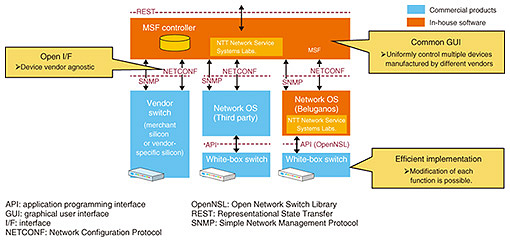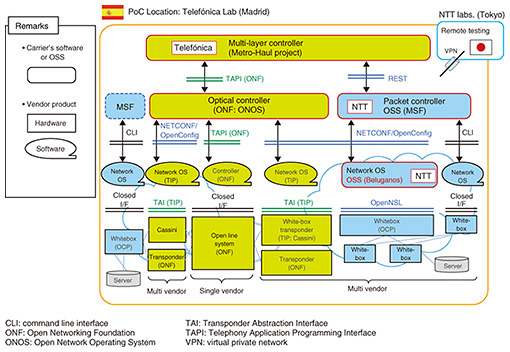 |
|||
|
|
|||
|
Short Reports Vol. 18, No. 3, pp. 79–82, Mar. 2020. https://doi.org/10.53829/ntr202003sr1 NTT and Telefónica Start PoC on Open Optical and Packet Transport Technologies within Telecom Infra Project1. IntroductionNTT and Telefónica announced that they have conducted a successful proof of concept (PoC) on open optical and packet transport technologies at the TIP Summit’19 held in November 2019 in Amsterdam, the Netherlands. A whitepaper of the PoC was published on the website of the Telecom Infra Project (TIP) in January 2020 [1]. The goal of the PoC is to implement open and commoditized networks to achieve wide scale economy for some components of the Converged Architectures for Network Disaggregation & Integration (CANDI) architecture and create an open market for disaggregated elements, both Internet protocol (IP) and optical. To achieve this goal, NTT and Telefónica created the CANDI sub-group under the framework of TIP’s Open Optical and Packet Transport (OOPT) project group in October 2018. In 2019, Orange, Telia Company, and the pan-European research network operator GÉANT joined CANDI. Only one year after the creation of the working group, the first collaboration PoC was completed in Madrid, Spain. With this PoC, the team succeeded in building a converged network with a packet technology controlling telecommunication traffic and an optical technology transmitting data long distance, following the required architecture, open technology and open interface promoted by CANDI. 2. NTT’s MSF and Beluganos development historyNTT has been engaged in the Multi-Service Fabric (MSF) project since 2014 to promote the use of open hardware provided by such communities as the Open Compute Project (OCP), leading to disaggregation between software and hardware in packet transport equipment and the network architecture and developing its system. This project is enhancing service reliability and flexibility of service development, as required by telecom operators. Since 2016, NTT has also started developing in-house software, Beluganos, which is a network operating system (OS) using an open interface controlling packet transmission chip in a white-box switch to activate the functions that are implemented by vendors (Fig. 1).
NTT has been disclosing both MSF and Beluganos as open source software (OSS) respectively to accelerate the development of open technology in the packet transport field and implementation of carrier-required features by multiple vendors to avoid vendor lock-in since 2017. In 2019, NTT contributed to and succeeded in a PoC through collaboration with Taiwan’s largest carrier Chunghwa Telecom by using these OSS. 3. Roles of Telefónica and NTTTo develop the PoC, Telefónica provided a multi-layer controller based on open standard interfaces with both the packet controller and optical controllers, and NTT provided an IP software-defined networking (SDN) controller (MSF) and network OS Beluganos as the reference model of the architecture and open interface (Fig. 2). Beluganos controls the OpenNSL (Open Network Switch Library) as an open interface of the packet transform chip of a white-box switch and also provides Netconf/Openconfig, which is becoming the de-facto open interface for remote-controlling packet devices. MSF succeeded in controlling three different network OSs on white-box switches and controlling the open interface that is Netconf/Openconfig for Beluganos.
This PoC is supported by Edgecore Networks, ADVA, IP Infusion, and Infinera, as TIP members. Open community, Open and Disaggregated Transport Network (ODTN) in Open Networking Foundation (ONF), and the Metro-Haul project funded by European Union provided implementation and support in the field of optical disaggregation. 4. Future prospectsThrough this PoC, NTT and Telefónica have started providing the feasibility of use cases required by the operators in CANDI. At the same time, they started a community to clarify the issues to be addressed for obtaining all the functions required by the use cases including scalability and operational issues. NTT and Telefónica will continue to contribute to conducting enhanced PoCs twice a year in CANDI to prove such feasibility and find issues with developing the technology required to confirm the feasibility of operators’ use cases. By maximizing the advantage of disaggregation technology and introducing the latest technology much earlier, NTT and Telefónica will contribute to avoiding vendor lock-in and enabling telecommunication networks with which people can use much more varied services faster. Reference
Telefónica executive’s commentEndeavor to Develop Open and Intelligent Cloud-native Transport Networks
Óscar González de Dios In the past years, Telefónica has been upgrading its IP and optical transport networks in a series of transformation projects, internally named “FUSION”, in order to deliver the transport requirements of the customers. However, the approach on fully relying on vendors’ proprietary solutions has led to delays in introducing new functions and innovations. Moreover the interfaces among the Operational support systems have been proprietary, non-programmable and closed interfaces that prevent new applications from a rapid and automated introduction. Telefónica is currently working on the full definition of Software Defined Transport Network model, named “iFUSION”, as main pillar of the network transformations, which covers the SDN-based control for core, metro and backhaul network segments including IP/MPLS, optics and microwave technologies. In order to introduce the network softwarization principles effectively, Telefónica chooses the standard technologies, especially those that are more mature in the industry, for interfaces and service models. On the other hand, while the fully aggregated model in optical networks is perfectly valid regarding its operation, it has prevented from quickly incorporating new transmission technologies from other vendors. In packet transport, hardware and software are currently coupled, so the capacity, features, and operation of the routers are tightly coupled. In that sense, Telefónica has an internal program, “openFUSION”, to foster the partial disaggregation of optical networks and commoditizing IP routers into white boxes. Telefónica has joined NTT to lead the CANDI initiative in an effort to foster openness in the Telco industry. The CANDI initiative in which NTT and Telefónica collaborate together with other operators is the perfect place to develop the solutions for an operator open network and drive the industry. With the PoCs, the CANDI initiative will continue to demonstrate the telco use cases with open standard interfaces, coordinated IP/Optical control and disaggregation. NTT researcher's commentTowards Flexible and Reliable Networks with Open Technologies
Minoru Yamaguchi NTT Network Service Systems Laboratories is researching and developing MSF and Beluganos and discloses them to achieve networks in which free choice and operation that meet operator requirements are possible as with server virtualization technology. These activities promote a highly flexible and reliable network. NTT's activities received approval from TIP, and a sub-group in which operators discuss use cases and architectures was established to drive disaggregation and open innovation. This was the first time we managed a community and conducted a PoC with carry-in equipment outside Japan. We conducted technical discussions with five operators and ran the secretariat in parallel. We also constructed an environment to conduct this PoC. We went to Telefónica Lab in Spain and built the environment in cooperation with Óscar and other participants. The PoC sometimes did not progress as expected because of time differences and language barriers as well as the circumstances of each company, but we could share common requirements and issues by organizing discussion items and roadmaps. We can interest many operators, vendors, and system integrators by spreading the results of this PoC as common requirements of operators, and we felt that our activities have great appeal. We would like to do our best for achieving flexible and reliable networks with open technologies by involving many people and working together. For inquiries:Public Relations Office, Planning Department, NTT Information Network Laboratory Group |
|||












